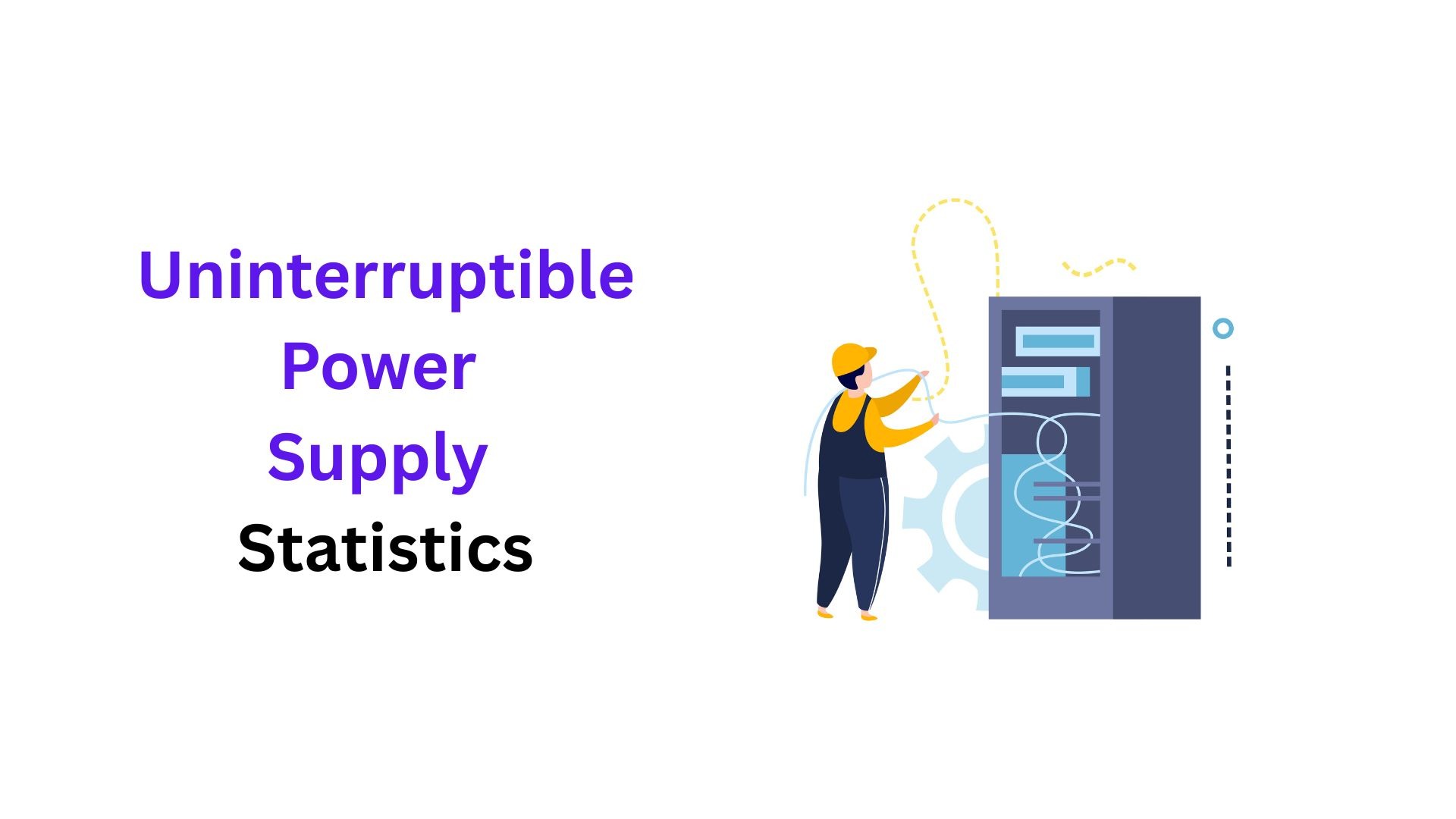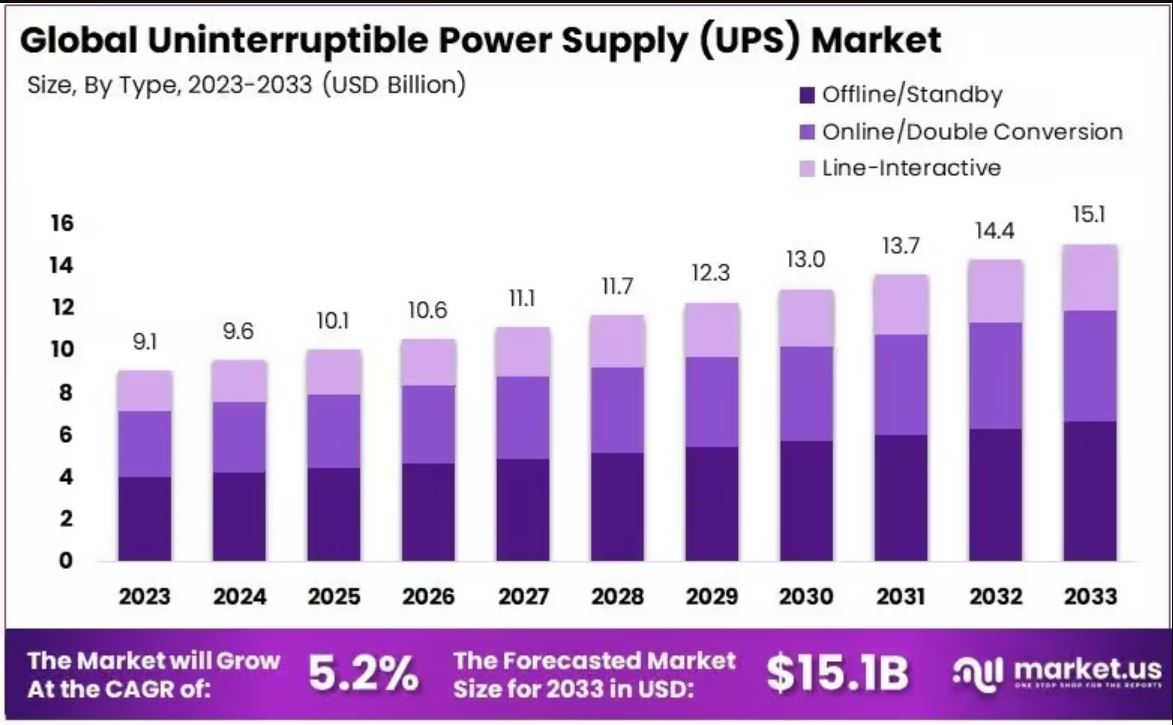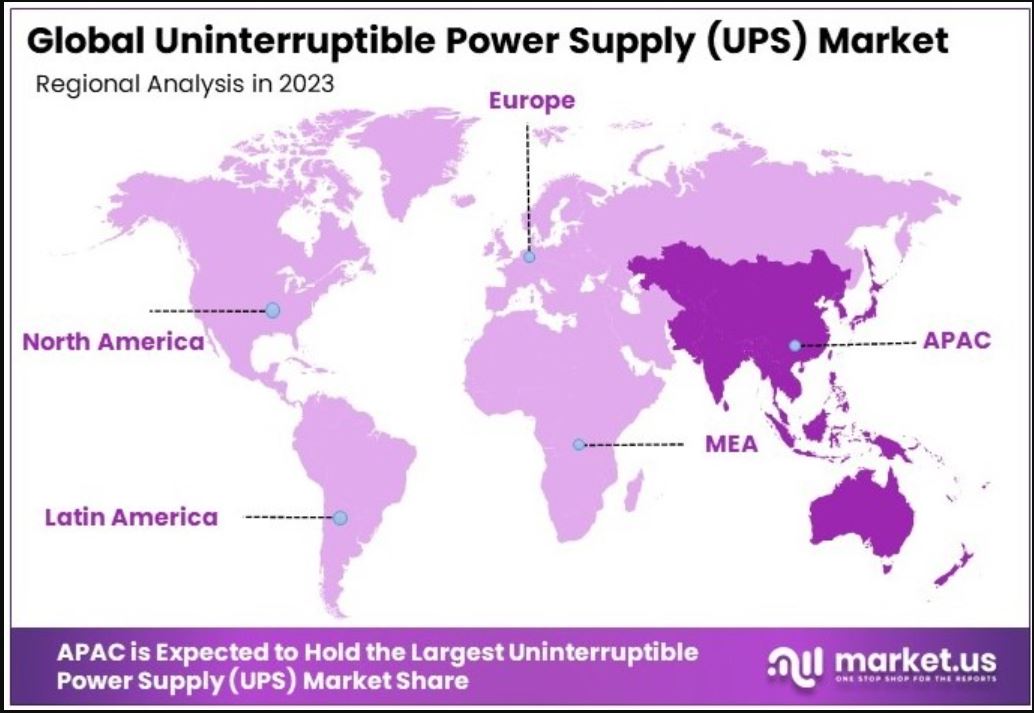Uninterruptible Power Supply Statistics And Facts (2025) | By Market Size, Regional Analysis, Manufacturers, Partnerships And Acquisitions, Demand And Trend
Updated · Nov 03, 2025

Table of Contents
- Introduction
- Editor’s Choice
- Uninterruptible Power Supply Market Size
- UPS Market Regional Analysis
- The World’s UPS Manufacturers Top
- Mitsubishi Electric Corporation
- UPS Industry Investments
- Partnerships And Acquisitions At UPS
- Why Demand Is Rising – Power Reliability And Outage Risk
- Frequency Of UPS Replacement And Maintenance Cost
- Real Prices You Can Expect (Retail Examples)
- Risks, Challenges, And Opportunities Ahead
- Conclusion
Introduction
Uninterruptible Power Supply Statistics: Power failures are no longer rare inconveniences; they are becoming an increasing global threat. In the digital-first world we live in today, where businesses, hospitals, and data centers rely on the smooth functioning of operations, even a moment of downtime can cause enormous losses in revenue and reputation.
Hence, the Uninterruptible Power Supply (UPS) market is seeing a major surge worldwide. Were it not for UPSs, valued at US$9.1 billion in 2023 and expected to rise to US$15.1 billion by 2033 (Market.us), there would be no protection from downtime, equipment damage, and lost productivity. In this article, we will showcase the trending Uninterruptible Power Supply Statistics.
Editor’s Choice
- The global UPS market was valued at US$9.1 billion in 2023 and is projected to hit US$15.1 billion by 2033, growing at a steady 5.2% CAGR.
- The 5–50 kVA power rating segment held the largest market share in 2023, widely adopted in commercial and industrial sectors.
- Asia-Pacific leads the global UPS market with a 35% share, powered by rapid industrialisation, digital transformation, and heavy infrastructure investments.
- In the Asia-Pacific region, primary energy demand was 291.8 exajoules in 2023, with an annual growth rate of 4.7% due to the higher demand for UPS solutions.
- The top manufacturers, such as Eaton, Emerson, Schneider Electric, Toshiba, ABB, Mitsubishi Electric, and Siemens, all maintain an active presence in developing advanced and energy-efficient UPS systems.
- DOI modelling concedes some critical warnings: by 2030, a potential for outage hours to be as high as 800 per year can be foreseen, thereby propelling enterprises toward embracing UPS systems as an essential insurance of protection against downtime.
- Services and maintenance account for nearly 80% of revenues in the UPS market, prohibiting the application value from being considered only from the purchase price.
- UPS pricing covers a fair range: US$250 to US$1,000 for small units for the home or office.
Uninterruptible Power Supply Market Size

(Source: market.us)
- As per Market.us, the uninterruptible power supply statistics show that the global uninterruptible power supply (UPS) industry has experienced a valuation of USD 9.1 bn in 2023 and will likely touch USD 15.1 bn by 2033, exhibiting a steady 5.2% CAGR in between.
- Among the different power ratings, the 5-50 kVA segment led with the largest market share in 2023 due to its high adoption in commercial and industrial sectors.
- By product type, the Offline or Standby UPS segment dominated, providing a cheaper backup option for small-scale usage.
- Being critical to storing power and ensuring system reliability, batteries also represent the largest component share.
- Data centers came out as the prominent end-user segment, heavily relying on uninterrupted power supply for their ceaseless operation.
- From a regional perspective, the Asia-Pacific truly led the market due to the rapid proliferation of data centres and enormous government investments in infrastructure.
UPS Market Regional Analysis

(Source: market.us)
- Asia Pacific owns the largest slice of the global UPS market with 35%, riding on rampant industrialisation and strong technological progress in countries such as China, Japan, and India.
- This region becomes barren due to a lack of heavy investments in infrastructure and more digital transformation and smart integration.
- Data center expansions, encouraged by the surging cloud services market, would further ensure that demand for UPS remains considered a top priority.
- Also, urbanisation is on its way to reshaping the region, with an urban population that is expected to rise by 50%, approximately adding about 1.2 billion people by 2050, which means much more energy consumption.
- In the year 2023 alone, the primary energy use reached 291.8 exajoules, a 4.7% increase from the prior year.
- Such dynamics and special emphasis on innovation, data protection, and energy efficiency are forcing businesses and governments to opt for the more advanced UPSs to ensure continuous power and operational stability.
The World’s UPS Manufacturers Top
Eaton Corporation Plc
- Eaton is a power management leader on the worldwide scene, recording sales of US$21.6 billion for the year 2018. Founded in the United States, the corporate offices are in Dublin, Ireland.
- The firm employs roughly 99,000 people in 59 nations and serves its customer base in over 175 nations.
- Eaton specialises in energy-efficient electrical, hydraulic, and mechanical power solutions, which aid industries in managing power more reliably and sustainably.
Emerson Electric Co.
- Emerson is a Fortune 500 company, now based in Ferguson, Missouri. It employs around 76,500 people and boasts 205 manufacturing sites worldwide.
- It has two major business arrays, Automation Solutions and Commercial & Residential Solutions.
- Under UPS, Emerson services its SolaHD™ portfolio with modular and industrial UPS systems, along with monitoring software.
- With Automation Solutions sales up 21% and Commercial & Residential Solutions up 2% in FY 2018, the company’s reach is extensive.
Schneider Electric
- In 2007, Schneider Electric acquired APC and merged it with MGE UPS Systems, developing the division of Critical Power & Cooling Services.
- The range of UPSs by Schneider goes right from single-phase to large three-phase kinds.
- Serious performers in the market included APC Symmetra PX and Smart-UPS VT, popular in data centers and enterprises.
- Schneider is considered a leading UPS manufacturer worldwide.
Toshiba UPS Systems
- Toshiba has been providing UPS systems through its Power Electronics division since the mid-’90s.
- It performs single-phase UPS systems (1–22 kVA) and three-phase UPS systems (13.5–16,000 kW). The 5000 Series UPS by Toshiba has been engineered for rugged outdoor conditions.
- Toshiba UPS solutions are installed across data centers, healthcare, telecom, and manufacturing industries.
ABB
- In 2018, the acquisition of GE Industrial Solutions for US$2.6 billion brought ABB into the fuller realm of UPS solutions.
- These systems provide single-phase (700 VA–10 kVA) and three-phase (15 kW–1500 kW) UPS covers.
- ABB UPS products are known for their energy efficiency, durability, and ENERGY STAR™ certification that cuts long-term operational costs.
- During FY 2018, ABB generated revenue of US$27,603,130,000, with operations in more than 100 countries.
Mitsubishi Electric Corporation
- Via the United States UPS division in the States, Mitsubishi Electric designs and markets IGBT-based high-efficiency double-conversion UPS systems.
- Its 9900 Series of UPSs offers from 6 kVA to 750 kVA, combining compact design with true on-line reliability.
- The Mitsubishi UPS is known for its energy efficiency, and the municipal offices and hospitals thus save on operational costs, while they maintain high uptime for their critical systems.
Siemens AG
- Siemens, the largest industrial manufacturer in Europe, offers UPS systems such as SITOP UPS500S, UPS1100, UPS1600, and UPS8600.
- Siemens enjoys revenues of over €12 billion at the global level, generated through multiple divisions, and employs its engineering prowess to ensure its UPS systems are the most reliable in applications pertaining to automation and industrial power.
UPS Industry Investments
- In September 2023, CBAK Energy Technology invested nearly US$35.57 million in acquiring a 5% stake in Shenzhen BAK Power Battery.
- The partnership is meant to join BAK Power’s development of 46800 battery models with CBAK Energy’s 46115 and 46157 models to strengthen the product supply chains while creating non-competition agreements on certain key areas.
- The year has just begun, and a new manufacturing campus was inaugurated in May 2024 in Helsinki, Finland, to expand the UPS system production, including the new 9395X.
- The UPS is smaller in size, occupying up to 30% less space, and uses silicon carbide converters for better energy efficiency.
- Meanwhile, February 2024 saw BPE unveil a strategic plan involving substantial investments and the launch of new products.
- A major highlight of the program was the land allotted for a new facility near Bhubaneswar, Odisha, under the Odisha State Industrial Development Corporation; the site supports the objectives of innovation, sustainability, and global business extending towards their 2025 horizon.
Partnerships And Acquisitions At UPS
- Delta Electronics India and Savex Technologies, one of India’s largest ICT distributors, entered into an MoU in September 2024.
- The partnership aims at widening Delta’s market by leveraging Savex’s extensive distribution network, focusing primarily on system integrators engaged in data centers, SMBs, and government projects.
- Months back, in June 2024, Ballard Power Systems walked hand-in-hand with Vertiv, creating hydrogen-fuelled backup-power solutions for critical infrastructure, which included data centers.
- The partnership undertook a proof of concept at the Ohio facility of Vertiv, wherein the fuel cell modules of Ballard were integrated with the Liebert EXL S1 UPS of Vertiv.
- In November 2024, Indian cloud and AI solutions provider E2E Networks partnered with one of India’s major technology conglomerates, Larsen & Toubro, to take Generative AI to the next level.
- This partnership combines E2E’s cloud platforms with L&T’s expertise in data center management and cloud solutions.
- Earlier in July 2024, Schneider Electric and AVEVA partnered with IN-CORE Systèmes for increased efficiency in electric vehicle battery production by linking electrode manufacturing data to final cell performance and providing feedback for process optimisation.
Why Demand Is Rising – Power Reliability And Outage Risk
- Department of Energy (DOE) and grid analysts stress that outage exposure would significantly grow in the coming years without major upgrades to the grid.
- DOE modelling shows that from the current single digits, annual outage hours could go beyond 800 per year by 2030 under stressed conditions.
- This impending reliability crisis is pushing businesses towards resiliency solutions such as UPS, coupled with on-site generation.
- Particularly disastrous for data centers are even a few minutes of downtime, which can translate to huge monetary and reputational losses.
- According to Uptime Intelligence Reports, outages continue to rank among the top three risks for operators, and consequently, redundancy and UPS planning become prime budget priorities.
- The warnings from the DOE truly reinforce why UPS systems increasingly have been regarded as insurance policies against outage risks.
Frequency Of UPS Replacement And Maintenance Cost
- Battery replacement cycles play a major role in the total UPS cost.
- Industry experience and vendor guidance suggest VRLA batteries need replacement every 4 to 6 years, whereas lithium-ion batteries, being able to last 8 to 10 or more years, nearly double the service life. This difference greatly influences lifecycle costing, as per Yahoo Finance.
- Further, services and maintenance, including warranty renewal, battery replacement, and system monitoring, account for nearly 80% of the UPS market revenues, as reported by Global Market Insights Inc.
- Such batteries with longer lifetimes, with infrequent replacement, entail infrequent maintenance, hence cutting down on maintenance costs on a significant scale.
Real Prices You Can Expect (Retail Examples)
- The variety of UPSes is huge and wide, in terms of technical and application criteria. From US$250 upward to US$1,000, home and office UPS units usually just cover about 500 VA to 1.5 kVA ratings from the likes of APC and CyberPower.
- At the price range of US$249-US$967, these are what Telequip Shop Online has on offer. On the other hand, medium-large rack-mount or modular data center UPS systems are relatively far more costly.
- Two to ten kVA systems can sell between US$5,000 and US$13,000, with higher charges for larger 6-50 kVA professional systems.
- An enterprise-grade system usually demands a billing in the high tens of thousands after installation, extra batteries, and redundancy features.
- These numbers underscore the chasm between a small office/home solution and a mission-critical data center infrastructure.
Risks, Challenges, And Opportunities Ahead
- Several risks and challenges characterise the future outlook of the UPS industry. Supply chains and component prices remain the biggest challenges.
- With battery materials and semiconductor prices fluctuating, often these price hikes are passed on by vendors to customers, thus impacting the cost of a UPS system.
- Another challenge relates to the fragmentation of the market sizing. Different analysts use different definitions for the UPS markets: some may include just core hardware, and others may extend it to batteries, services, and maintenance.
- Making estimates of market growth size for the same years can range from an average of US$12 billion to above US$30 billion, a big enough gap to warrant one’s checking on the methodology behind such numbers.
- At the same time, a major concern involving sustainability is shaping all purchase decisions.
- Generally speaking, Li-ion batteries, because they last longer and take up less space, tend toward a more favourable temporary environmental impact compared to repeated VRLA battery replacements.
- These changes lend support to corporate sustainability programs and are fast becoming a major factor in many organisational choices to favour Li-ion over older technologies.
Conclusion
Uninterruptible Power Supply Statistics: UPS has transitioned from being just a backup to an integral part of modern infrastructure. Hence, it is growing fast on the back of increasing outbound risks, crashing cloud adoption, and demands for dependable energy. The major players, such as Eaton, Schneider, and ABB, investing heavily in R&D, present the industry itself as a promising one for long-term growth.
Though it does face challenges in the cost of components and a lack of consolidated market sizing. The drive for sustainability and greater Li-ion adoption tends to reshape strategies in such a way that UPS solutions are not only reliable but also comply with global efficiency and environmental goals.
FAQ.
The global UPS market was valued at US$9.1 billion in 2023 and is forecast to grow to US$15.1 billion by 2033, at a steady 5.2% CAGR (Market.us). The growth was due to digital transformation, industrial growth, and rising concerns over energy reliability worldwide.
Asia-Pacific holds its leadership position with 35% of the global market share. Further led by China, India, and Japan. The factors of rapid industrialisation, growing cloud adoption, and rising power consumption-291.8 exajoules of energy in 2023, up 4.7% YoY-give the region the highest demand for UPS.
UPS systems are most critical within data centers, in which power interruptions may engender costly downtime. And the other industries adopting UPS systems in large numbers are healthcare, manufacturing, telecom, and government, with power reliability being directly related to safety, operations, and productivity.
VRLA batteries usually last between 4 and 6 years, while lithium-ion batteries last for 8 to 10+ years. According to Yahoo Finance, lithium-ion batteries last longer, have a smaller footprint, and lower long-term costs; hence, companies prefer them while seeking sustainability and reduced expenses concerning maintainability.
Depending on scale, pricing varies. Home and office UPS systems are great for up to 1.5 kVA range, anywhere between US$250 and US$1,000. On the other hand, for large-scale data center installations, the price starts from US$5,000 and can go upwards of US$50,000, especially when factoring in installation, redundancy, and battery scalability.

I hold an MBA in Finance and Marketing, bringing a unique blend of business acumen and creative communication skills. With experience as a content in crafting statistical and research-backed content across multiple domains, including education, technology, product reviews, and company website analytics, I specialize in producing engaging, informative, and SEO-optimized content tailored to diverse audiences. My work bridges technical accuracy with compelling storytelling, helping brands educate, inform, and connect with their target markets.










